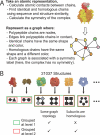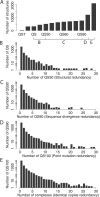3D complex: a structural classification of protein complexes
- PMID: 17112313
- PMCID: PMC1636673
- DOI: 10.1371/journal.pcbi.0020155
3D complex: a structural classification of protein complexes
Abstract
Most of the proteins in a cell assemble into complexes to carry out their function. It is therefore crucial to understand the physicochemical properties as well as the evolution of interactions between proteins. The Protein Data Bank represents an important source of information for such studies, because more than half of the structures are homo- or heteromeric protein complexes. Here we propose the first hierarchical classification of whole protein complexes of known 3-D structure, based on representing their fundamental structural features as a graph. This classification provides the first overview of all the complexes in the Protein Data Bank and allows nonredundant sets to be derived at different levels of detail. This reveals that between one-half and two-thirds of known structures are multimeric, depending on the level of redundancy accepted. We also analyse the structures in terms of the topological arrangement of their subunits and find that they form a small number of arrangements compared with all theoretically possible ones. This is because most complexes contain four subunits or less, and the large majority are homomeric. In addition, there is a strong tendency for symmetry in complexes, even for heteromeric complexes. Finally, through comparison of Biological Units in the Protein Data Bank with the Protein Quaternary Structure database, we identified many possible errors in quaternary structure assignments. Our classification, available as a database and Web server at http://www.3Dcomplex.org, will be a starting point for future work aimed at understanding the structure and evolution of protein complexes.
Conflict of interest statement
Figures







References
-
- Alberts B. The cell as a collection of protein machines: Preparing the next generation of molecular biologists. Cell. 1998;92:291–294. - PubMed
-
- Gavin AC, Aloy P, Grandi P, Krause R, Boesche M, et al. Proteome survey reveals modularity of the yeast cell machinery. Nature. 2006;440:631–636. - PubMed
-
- Berman HM, Battistuz T, Bhat TN, Bluhm WF, Bourne PE, et al. The Protein Data Bank. Acta Crystallogr D Biol Crystallogr. 2002;58:899–907. - PubMed
-
- Murzin AG, Brenner SE, Hubbard T, Chothia C. SCOP: A structural classification of proteins database for the investigation of sequences and structures. J Mol Biol. 1995;247:536–540. - PubMed
-
- Orengo CA, Michie AD, Jones S, Jones DT, Swindells MB, et al. CATH: A hierarchic classification of protein domain structures. Structure. 1997;5:1093–1108. - PubMed
Publication types
MeSH terms
Substances
Grants and funding
LinkOut - more resources
Full Text Sources
Other Literature Sources

